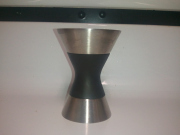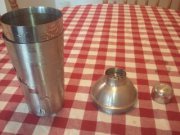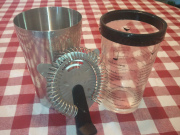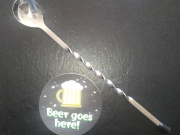Contents
Bar Tools
There are a lot of bar tools that you can use in your home bartending experience. However, you’re an amateur, and you’re probably so poor that you look at websites for tips instead of buying books on the subject. So, I’m going to give a (very) list just a handful of basic items that one ought to have in their home bar. These are the three bar tools that I use the most. Invest in these few items, and you’ll have the basics to make a lot of drinks. From there, you can expand your collection as you see fit in order to make more specialized drinks.;
Jigger

A very important, yet possibly offensive, jigger.
This has a pretty silly sounding name, it is a real thing, and, as far as I’m concerned, it’s the most important piece of equipment you need for mixing drinks (though several people are bound to disagree). A jigger is a measuring device with two ends. Most commonly one end holds up to an ounce of liquid (the pony) while the other end holds up to an ounce and a half (the jigger). Some may also go as high as two ounces. There are different kinds (some with spouts, making it a lot easier to pour slowly and layer drinks), but I recommend one with measuring marks within each cup so you can precisely measure a 1/4, 1/3, 1/2, 2/3, and 3/4 ounce. Without this device, your drinks will be off, usually too weak or too strong. Or just too gross. So go out and a get a jigger — just be careful about saying that word too loudly in a public place.
Cocktail Shaker
Your shaker is also extremely important. While you can simply mix most drinks in a glass, getting a good shaker will help you mix and chill the drinks properly. You can get either a standard shaker or a Boston shaker. Most amateurs use the standard shaker, while most bartenders use the Boston shaker.

A standard shaker.
The standard shaker has three parts: the tin, the strainer top, and the cap. The strainer top fits into the tin, and the cap fits on top of the strainer top. This is easy to use, but a bit slower than the Boston shaker, and, since all of the pieces are metal, they tend to stick together after you’ve shaken something with ice. However, the chances of spilling your drink are much less if you’re mixing a drink that’s more than four ounces.

A Boston shaker and a Hawthorne strainer.
A Boston shaker, on the other hand, is made out of two pieces: the mixing glass and the tin. You pour your ingredients into the glass, and then fit the tin on top of the glass to form a seal, and begin shaking (or just stir the drink in the mixing glass if it’s a stirred drink). You’ll have to buy a separate strainer (a Hawthorne or julep strainer, either of which should fit snugly into the tin) in order to strain your drinks, as well. This shaker is a lot quicker, but it does risk spillage when you make larger drinks.
A small note: a lot of shakers these days come with recipes on their sides. While this is somewhat useful, they can be misleading or inaccurate. These recipes often tell you the ingredients, but not how to make it, and not whether ice is in the final drink, or just when you’re making it. Worse still, they often include recipes for drinks that you would never make in a shaker, like the tequila sunrise, which is always, ALWAYS built in the serving glass.
Bar Spoon

A bar spoon, along with an incredibly amusing and witty coaster.
No, I’m sorry, but you probably shouldn’t use a normal spoon for stirring. The bar spoon is extra long and thin, so that you can better stir tall drinks and get to the bottom of that mixing glass. It also has a spiraled handle to either help you layer drinks (I’ll talk about that some other time), or stir in a different way (by placing the spoon in the middle of the cup, and twirling the handle between your palms to make the spoon rotate). You can also either stir with the spoon end or the handle end, depending on your cup and ice. The spoon end is also useful for layering drinks, which, I swear, I will talk about at some point.
Miscellaneous
Excluding glassware, those are the bar tools I use the most. You’ll probably also want cocktail stirrers (those little things you always thought were straws) to stir lowball drinks. Other pieces of bar equipment include speed pours, pairing knifes and cutting boards, measuring spoons (which you are likely to already have), ice scoops/tongs, an electric blender (for frozen drinks), a stove (for hot drinks), a muddler, a grater, a bottle opener, a corkscrew (these last two are important, but I use them less because I’ve become a liquor drinker more often than not), a juicer or citrus reamer, and, of course, cocktail napkins.

